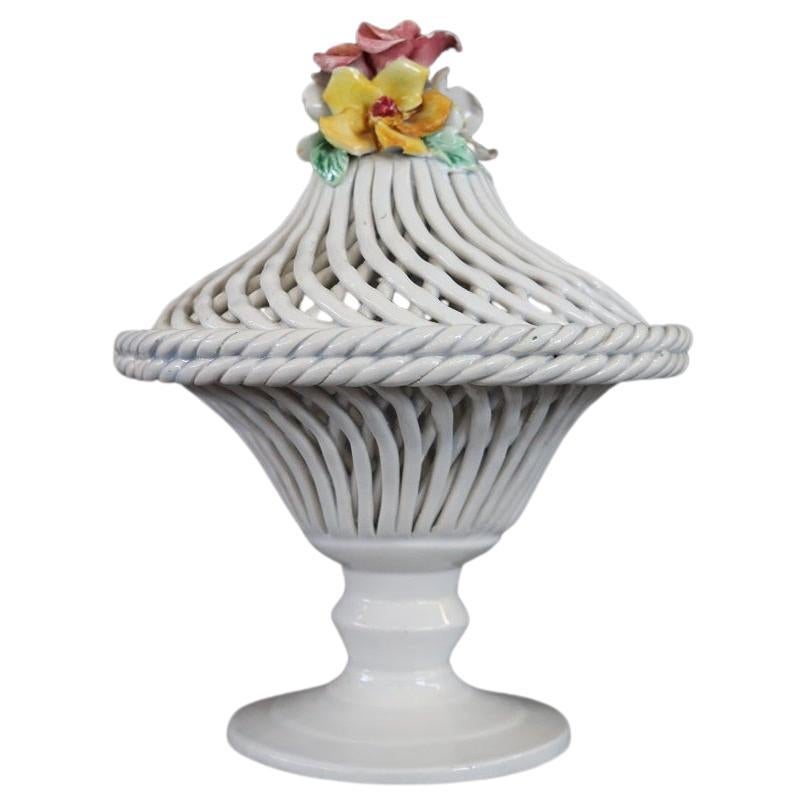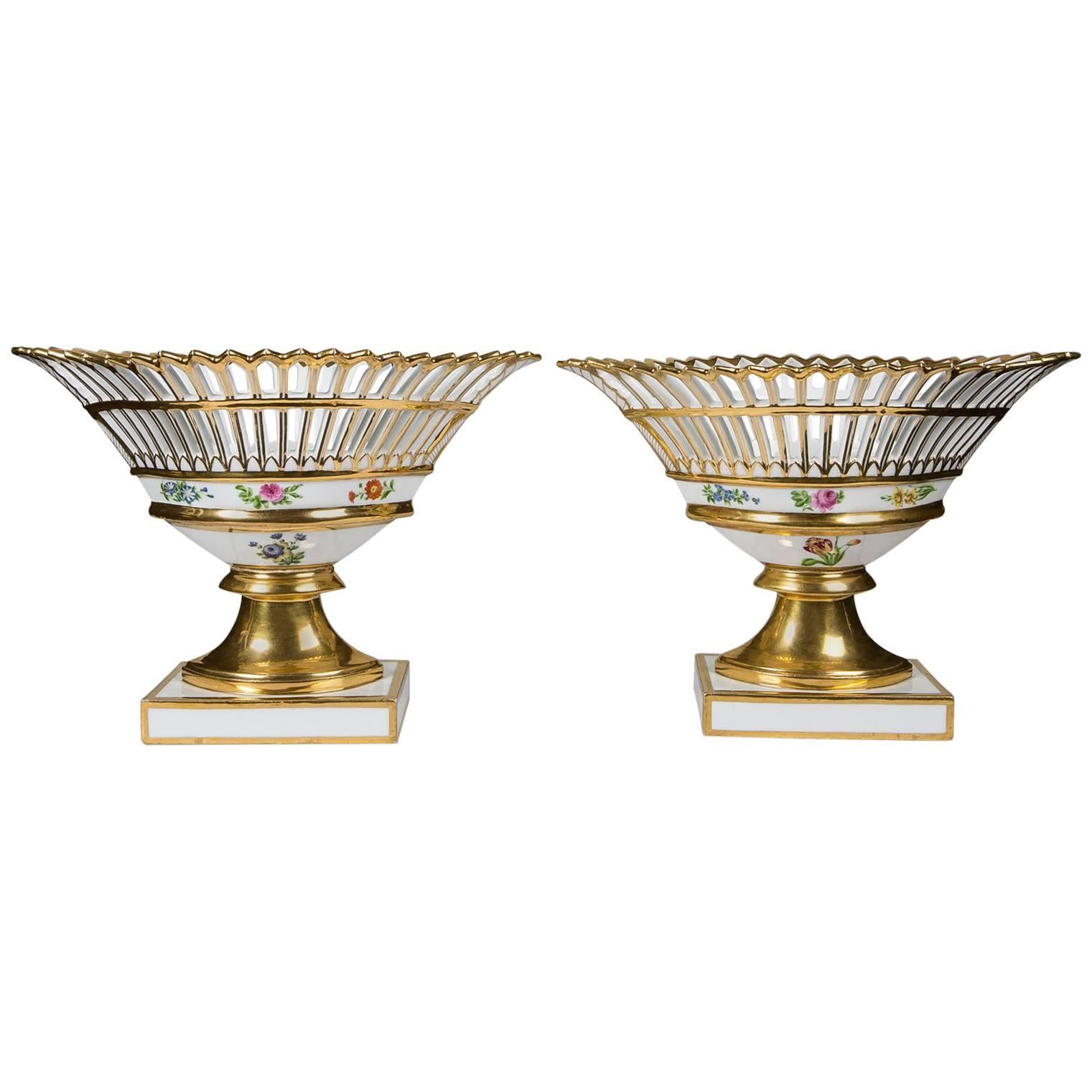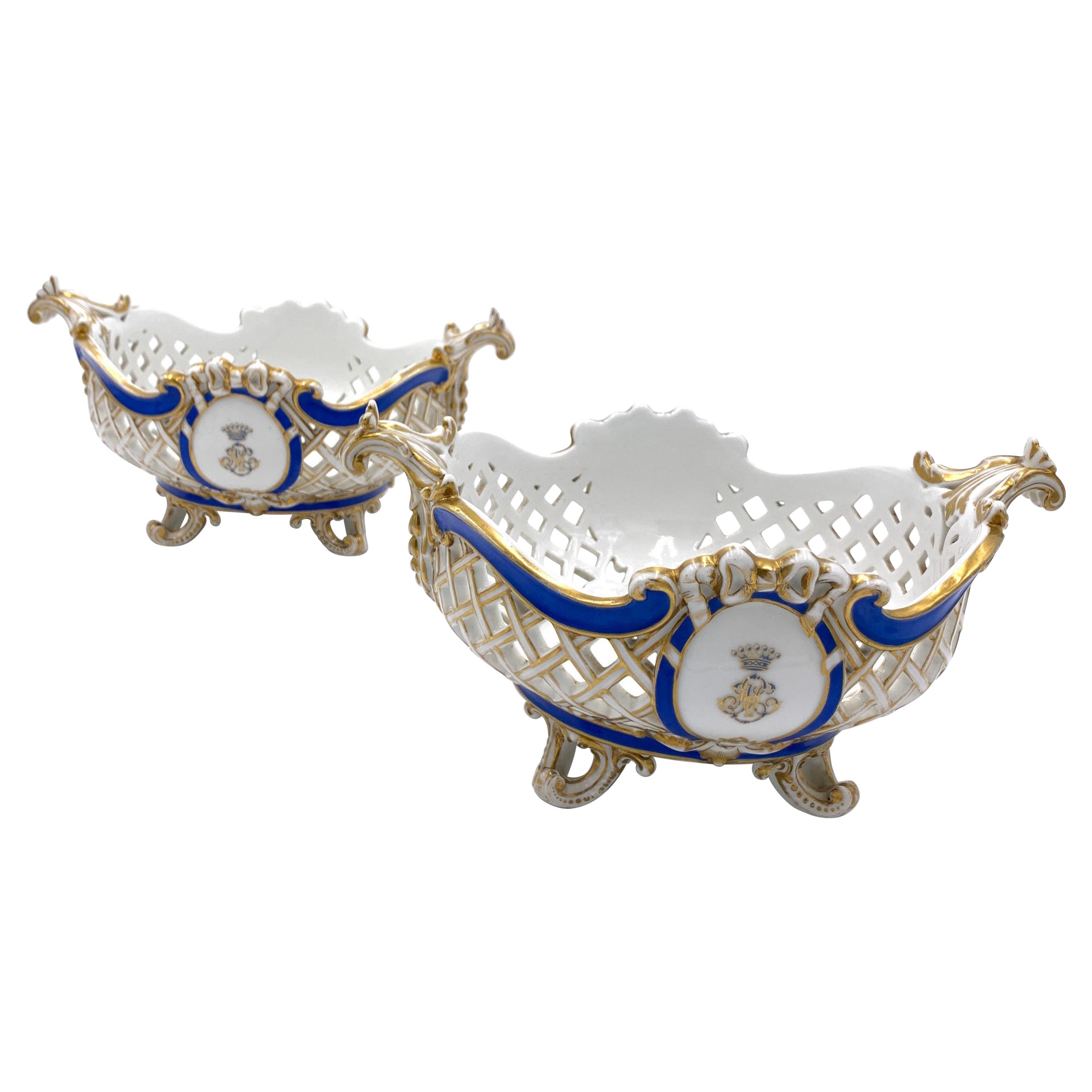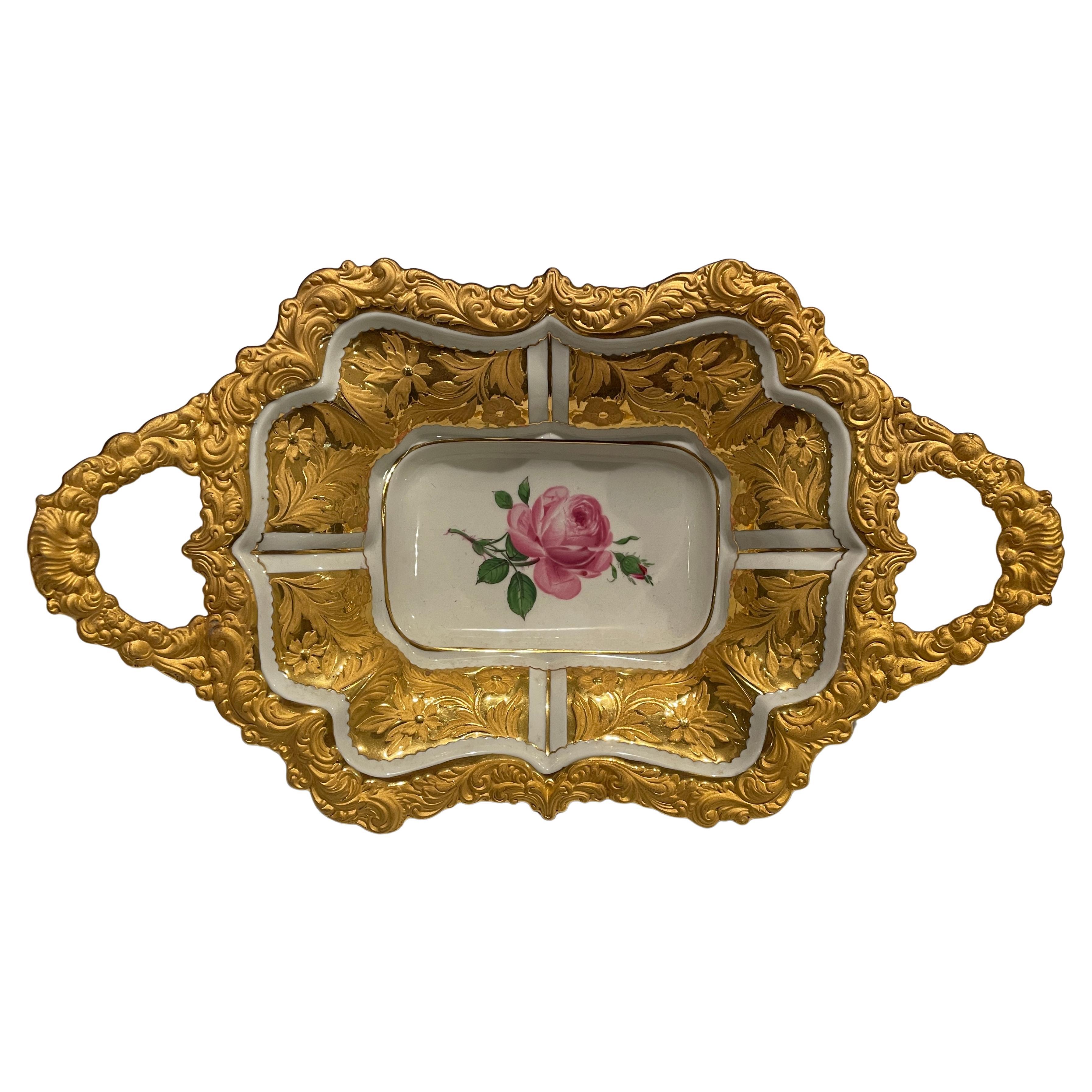Items Similar to Pair of Sèvres Bisque Porcelain Winged Lions Bearing Gilt Baskets
Want more images or videos?
Request additional images or videos from the seller
1 of 11
Pair of Sèvres Bisque Porcelain Winged Lions Bearing Gilt Baskets
About the Item
After a Model by Alexandre-Evariste Fragonard
Rare Pair of Sèvres Bisque Porcelain Winged Lions
Bearing Gilt Baskets
Sèvres Royal Manufactory, Restoration period, circa 1826-1828
Height 35cm; width 38.7 cm; depth 19 cm
One of the lions bears the incised marks J 6 26 and N° 2/Mars; one of the baskets is marked with a blue fleur-de-lis, Sèvres/28, the gilt mark MC. G (?) Mars and the incised numbers “24-4”.
Each of the Sèvres bisque porcelain lions is depicted as advancing calmly and majestically, with its jaws open, its tail curved under its body, and a finely detailed mane. A pair of wings reminiscent of those of ancient Assyrian lions sprouts from its shoulders; each of the felines is fitted with a draped saddlecloth that is moulded with low-relief stylised motifs including palmettes and scrolling foliage and is bordered with tassels. A pierced gilt porcelain basket decorated with foliate motifs is borne on the back of each beast. Both lions stand on their original rectangular imitation marble tôle-peinte base.
The design of this magnificent pair of “canephore” (basket-carrying) lions is based on an 1817 project by Alexandre-Evariste Fragonard. Fragonard’s original drawings featured a lion and a lioness carrying baskets, which were intended to accompany a group of basket-carrying Egyptian figures, as part of a lavish bisque and gilt porcelain surtout de table. It seems that only the lion figure was produced in the Manufactory’s atelier, under the direction of sculptor Jean-Charles-Nicolas Brachard. The first such lions appear in the Sèvres inventories in December 1818; they were exhibited at the Louvre the following year (Fragonard’s original drawings and Brachard’s preliminary plaster figures are today in the Sèvres Museum).
Only a very few identical examples are known; these are generally single figures whose mate has not survived. One example, made circa 1818, is in the collection of the Foreign Ministry in Paris (illustrated in M. Brunet and T. Préaud, Sèvres des origines à nos jours, Office du Livre, Fribourg, 1978, p. 291, fig. 354); two other examples appear in T. Préaud, The Sèvres Porcelain Manufactory, Alexandre Brogniart and the Triumph of Art and Industry, 1800-1847, The Bard Graduate Center for Studies in the Decorative Arts, New York, 1997, p. 358, plate 143; one further such lion is in the Mobilier national in Paris (illustrated in Le XIXe siècle français, Collection Connaissance des Arts, Hachette, Paris, 1957, p. 80).
Alexandre-Evariste Fragonard (1780-1850)
The son of the famous painter Jean-Honoré Fragonard, he first trained in his father’s workshop, then became the assistant of the painter David. The latter, speaking of his student’s talent, said: “there is oil in that lamp”. The young Fragonard quickly gained a reputation as a painter and sculptor, receiving numerous public and private commissions. During the Restoration period he created many models for the Royal Sèvres Manufactory. One of the most active participants in the renewal of the French decorative arts, he was a champion of the “Troubadour style”, which was influenced by the architecture, painting and decorative arts of the Middle Ages.
- Creator:Alexandre-Évariste Fragonard 1 (Artist)
- Dimensions:Height: 13.78 in (35 cm)Width: 15.24 in (38.7 cm)Depth: 7.49 in (19 cm)
- Sold As:Set of 2
- Style:Restauration (Of the Period)
- Materials and Techniques:Porcelain,Sèvres
- Place of Origin:
- Period:
- Date of Manufacture:circa 1826-1828
- Condition:Wear consistent with age and use. Certificate of authenticity. Fully overhauled upon sale.
- Seller Location:Paris, FR
- Reference Number:
About the Seller
No Reviews Yet
Vetted Seller
These experienced sellers undergo a comprehensive evaluation by our team of in-house experts.
1stDibs seller since 2015
- ShippingRetrieving quote...Ships From: Paris, France
- Return PolicyThis item cannot be returned.
More From This SellerView All
- Sèvres Porcelain Louis XVI Lyre Mantel Clock by Kinable, Dial by DubuissonBy Dubuisson, Dieudonné KinableLocated in Paris, FRDieudonné Kinable Enamel Dial Attributed to Dubuisson (1731-1815) Exceptional Porcelain Lyre Mantel Clock from the Royal Sèvres Porcelain Manufactory Paris, late Louis XVI period, circa 1785-1790 Height 62 cm; width 26 cm; depth 16 cm The round enamel dial, signed “Kinable”, indicates the hours in Roman numerals, the fifteen-minute intervals in Arabic numerals, the annual calendar and the signs of the Zodiac, by means of four hands, two of which are made of pierced gilt bronze, the two others in blued steel. The magnificent lyre-shaped case is made of “bleu nouveau” Sèvres porcelain and finely chased and gilt bronze. The bezel is made up of a gilt bronze twisted rope; the pendulum is adorned with brilliant-cut paste stones; the body of the lyre is adorned with gilt bronze beading and with laurel leaf and seed motifs, with two rosettes issuing floral and foliate swags. The clock is surmounted by a mask with radiating sunrays. The spreading foot is decorated with beading and twisted rope motifs and a leafy garland. The en-suite decorated oval base is raised upon four flattened ball feet. The Royal Sèvres Porcelain Factory produced the lyre clock model as of 1785. Four colours were offered: turquoise, green, pink and bleu nouveau. These exceptional clocks were made for the connoisseurs of the time. Louis XVI had a similar clock in his Salon des jeux in Versailles; its dial bore the signature of the clockmaker Courieult (this is almost certainly the example illustrated in P. Verlet, Les bronzes dorés français du XVIIIe siècle, Paris, 1999, p. 41). Kinable, however, was the clockmaker who purchased the greatest number of lyre cases from the factory, and he developed the model in the late 18th century. Among the porcelain lyre clocks signed by this brilliant horologer, one example is in the Victoria & Albert Museum in London (illustrated in H. Ottomeyer and P. Pröschel, Vergoldete Bronzen, Band I, Munich, 1986, p. 252, fig. 4.6.26). A second such clock is in the Royal British Collection (see C. Jagger, Royal Clocks, The British Monarchy & its Timekeepers 1300-1900, 1983, p. 130, fig. 176). Bibliography: M. Gay and A. Lemaire, “Les pendules lyre”, in Bulletin de l’Association nationale des Collectionneurs et Amateurs d’Horlogerie ancienne, Winter 1993, n° 68, p. 5-40. Dieudonné Kinable (active circa 1785-1810) One of the most important Parisian clockmakers of the late 18th century. His shop was located at n° 131 Palais Royal. He purchased a great number of lyre-type porcelain clock cases...Category
Antique 1780s French Louis XVI Mantel Clocks
MaterialsBronze
- Chased Gilt Bronze Rocaille Louis XV Cartel by Viger, Case Attributed to OsmondBy François VigerLocated in Paris, FRFrançois Viger, reçu maître horloger reçu maître en 1744 Case Attributed to Robert Osmond (1711-1789), reçu maître fondeur en janvier 1746 Im...Category
Antique 1750s French Louis XV Wall Clocks
MaterialsBronze
- “Cercles Tournants” Louis XVI Mantel Clock, Bronze Attributed to GouthièreBy Pierre GouthiereLocated in Paris, FRImportant white marble “Cercles Tournants” mantel clock. Gilt bronze mounts attributed to Pierre Gouthière. Paris, Louis XVI period, circa 1775...Category
Antique 1770s French Louis XVI Mantel Clocks
MaterialsMarble, Bronze
You May Also Like
- Porcelain Compote Pierced Basket Bowl w/Lion Paw Feet Regency Empire StyleBy Vista AlegreLocated in New York, NYA beautiful oblong white and gold pierced 'Paris Porcelain' style porcelain compote basket bowl with lion paw feet in the Regency / Empire st...Category
Mid-20th Century Portuguese Regency Decorative Baskets
MaterialsGold
- Italian Hand Painted Porcelain Decorative BasketLocated in Casale Monferrato, ITBeautiful small decorative basket in fine hand-painted italian porcelain, circa 1990s. Beautiful decoration with flowers on top. The lid opens and the basket can be used to hold sweets.Category
1990s Italian Porcelain
MaterialsPorcelain
- Pair French Gilded Porcelain Baskets 'Corbeilles' Made Mid-19th CenturyLocated in Katonah, NYOriginally this pair of elegant oval-shaped Paris porcelain pierced baskets (corbeilles) were used in a table setting to hold fruit. Their timeless beauty will enhance any room. Th...Category
Antique Mid-19th Century French Louis Philippe Decorative Baskets
MaterialsPorcelain
- Marcolini Period Meissen Porcelain Open Work Fruit BasketLocated in London, GBFine Marcolini Period Meissen Porcelain open work fruit basket in white, blue and gold, two crowns on each basket at the front and the revers of the basket, signed and dated on the b...Category
Antique 19th Century French Decorative Baskets
MaterialsPorcelain
- Paris Porcelain Gilt Banded Hunting ServiceLocated in New York, NYParis porcelain gilt banded hunting service. Set of sixteen complementary serving dishes with hunt paintings attributed to Jacques François Joseph Swebach, a painter for Serves porcelain as well as Royal Russian Porcelain manufactory; his work found at The Met, Musée des Beaux-Arts in Lyon and Marseille. Scenes include red and blue coated hunters riding to the hounds, running stag, wild boars, foxes and groupings of hounds. Each scene bordered in thick gilt band on white ground with filigree border and further gilt banding. Sweet meat dishes...Category
Antique Early 19th Century French Empire Porcelain
MaterialsPorcelain
- Meissen Gilt and Painted Porcelain TrayBy Meissen PorcelainLocated in Norwood, NJTwo handled Meissen heavily gilded charger or tray with pink rose painted flower in center and raised gold flower and leaf decoration on interior panels as well as rim and handles. C...Category
Early 20th Century German Porcelain
MaterialsGold





